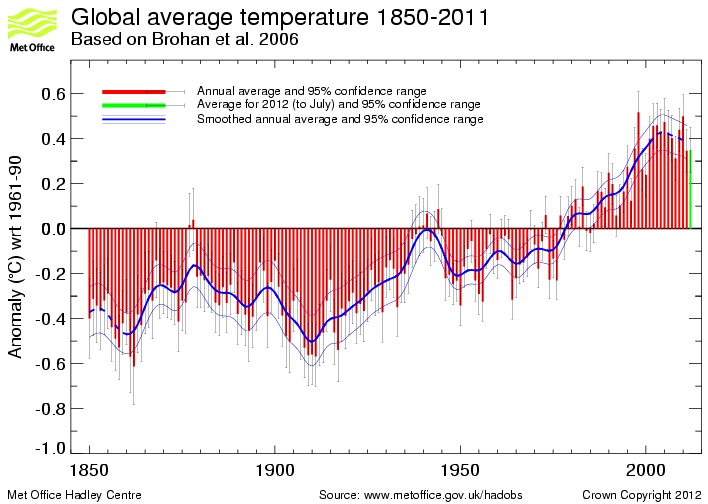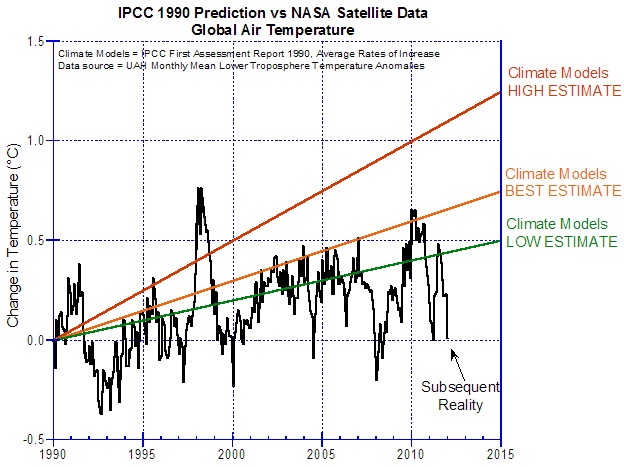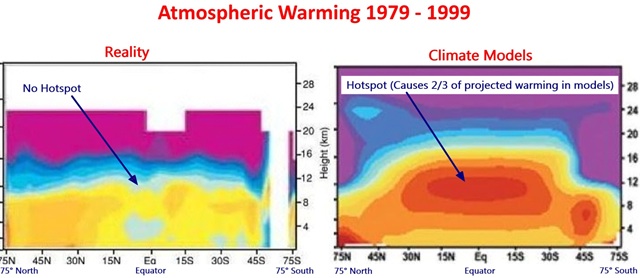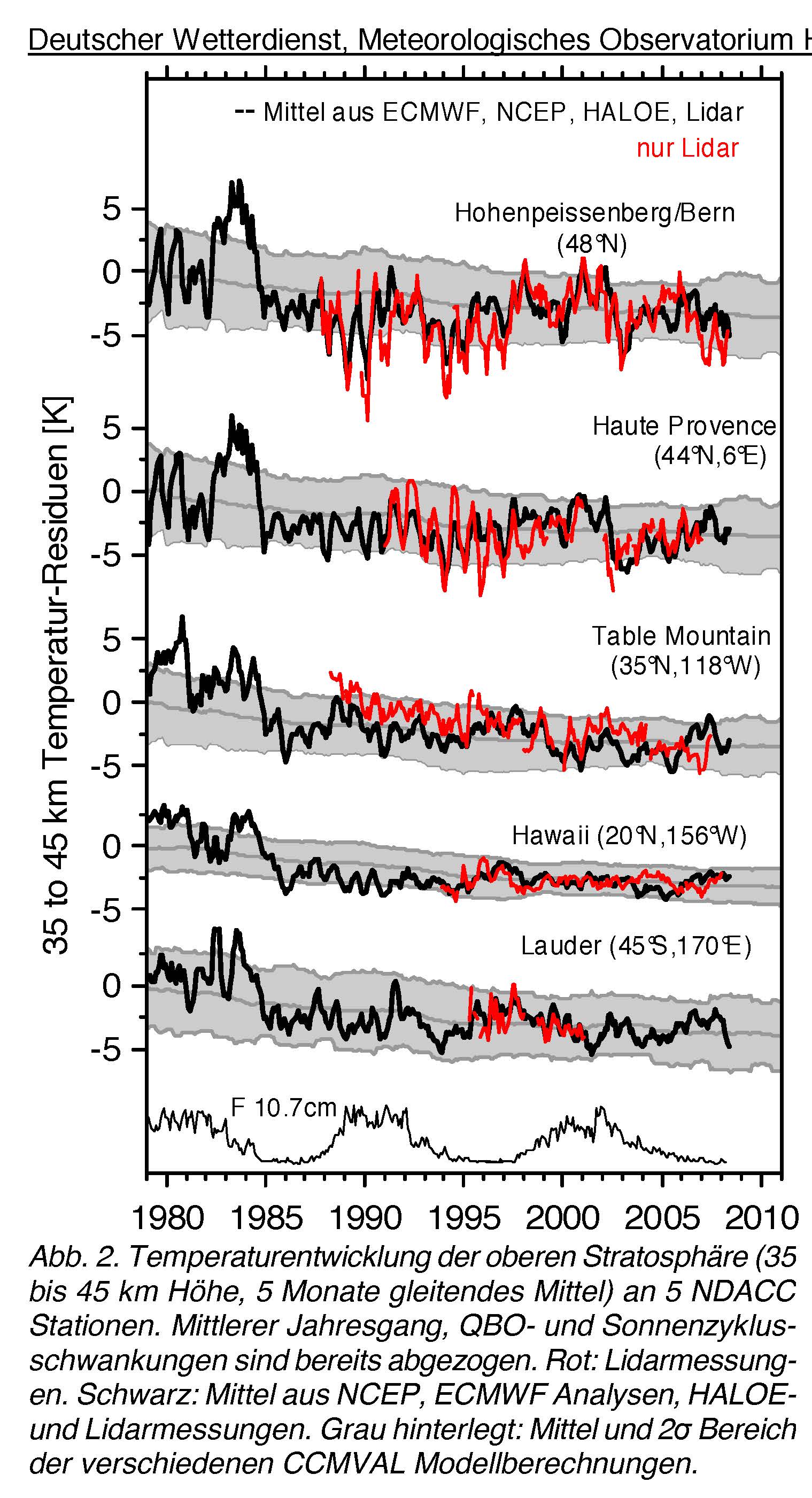By Klaus-Eckard Puls
Meteorologist, European Institute for Climate and Energy (EIKE)
(Translated with permission, edited by P Gosselin)
 Climate model trends have been providing prognoses (scenarios) for temperatures for the various atmospheric layers for about 2 decades: near the ground surface, troposphere and stratosphere.
Climate model trends have been providing prognoses (scenarios) for temperatures for the various atmospheric layers for about 2 decades: near the ground surface, troposphere and stratosphere.
According to the CO2 hypothesis, the atmosphere from ground level to the upper troposphere is supposed to warm up while the stratosphere is supposed to cool. However, meteorological measurements show that just opposite is occurring!
Institutes close to the IPCC have been conveying temperature prognoses (scenarios) in the media of spectacular and supposedly dramatic warming trends for surface temperatures for about three decades. However, the atmosphere can not be simply reduced to this relatively thin lower layer, and thus it has to be taken into account as a whole.
Figure 1, above, shows the levels of the atmosphere (image source K.E. Puls).
One atmospheric interaction is that when it gets warmer in the troposphere, it gets colder in the stratosphere – and vice versa.
For this reason there are also considerations and claims by the climate models on how the temperature at various altitudes is supposed to develop according to the AGW CO2 hypothesis.
These involve mainly:
– the lower troposphere
– the upper troposphere (hot spot)
– the stratosphere
1) The Lower Troposphere Model Failure
According to the climate models, global temperatures near the surface are supposed to increase about 3°C during the 21st century: “For the next two decades…a warming of 0.2°C per decade is projected” [1].
But since 1998 there’s been no trace of warming. There hasn’t been any warming in 14 years, despite steadily increasing atmospheric CO2 concentrations. Yet, this did not prevent the IPCC from making the absurd claim:
Progress in modelling…has allowed the specification of very narrow ranges of uncertainty for projected warming….”
But the most recent evaluation of the HADLEY Institute (CRU) up to July 2012 shows that precisely the opposite is true. There’s been a slight cooling over the last 14 years, what many refer to as a temperature plateau:
Figure 2: Global temperature 1850-2012 (Source: http://www.metoffice.gov.uk/nh+sh/)
The contradiction becomes even more stark when IPCC prognoses are directly compared to measured temperatures:
Figure 3: IPCC prognosis vs. NASA sat. data (Source: http://wattsupwiththat.com).
2) Upper Troposphere Model Failure
According to the climate models, the upper troposphere is supposed to show a distinct warming, a so-called “hot spot”:
“Theory states that the hot spot is supposed to be created by additional evaporation, and the additional evaporation transports warmer and wetter air to altitudes where cooler and drier air masses once prevailed.” (read here).
But weather balloons have been unable to confirm this, and in fact show that precisely the opposite has occurred!
Figure 4, left: From data from millions of weather balloons, right: what the models predicted. Source: http://wattsupwiththat.com.
This also means that all models with a temperature prognosis over 1°C or more because of the “sure” water vapour amplification are falsified. According to the Die kalte Sonne website (www.kaltesonne.de/?p=4803):
Only a few people in the climate discussion are aware that CO2 is not the main driver, and that most of the warming is assigned to the dubious amplification mechanism. CO2 by itself only has a warming potential of 1.1°C per atmospheric concentration doubling. It is only through the theoretical assumption of the up-to-now poorly understood amplification mechanism that the warming gets catapulted by the IPCC to 2.0-4.5°C per CO2 doubling, mainly through water vapour and clouds.”
And:
A coupling between CO2 and water vapour is at this time not detectable.”
3) The Stratosphere Model Failure
The developments and effects of ozone, CO2, and the temperature in the stratosphere have long since been well illustrated by the German Weather Service (DWD) in one of its ozone bulletins [2]. There it is stated:
In the stratosphere…the absorption of sunlight by the plentiful ozone trace gas is the main source of heat. …Naturally the absorbed radiative energy must be given off once again. In the stratosphere this occurs…for the most part through heat radiation into space by CO2 molecules. Therefore CO2 in the atmosphere has a cooling effect, ozone a warming effect!”
And also cited there:
While CO2 in in the atmosphere has increased over the last decades, and ozone in the upper stratosphere (40 km) has reduced by almost 20% since the 1970s, (see Bulletin No. 103), …therefore it has to be expected that the CO2-cooling in the stratosphere would have had to increase over the last years, while ozone warming should have reduced. That means the upper stratosphere should have gotten colder over the last decades! Indeed almost every chemical-climate model, e.g. within the scope of the CCMVAL project (http://www.pa.op.dlr.de/CCMVal/) foresaw a cooling of about 1°C per decade for the upper stratosphere at 40 km .”
The actual measurements in the stratosphere between 1980 and 2008 yield completely different results, and are shown in in Figure 5:
The German Weather Service explicitly writes:
While the models show a steady and gradual cooling, the measurements at all stations show an entirely different development: A cooling was indeed the case until the end of the 1980s. Over the last 20 years all the temperatures at practically all the stations have remained more or less steady (exception data from Table-Mountain Lidars).”
According to Figure 5) The DWD writes:
…the gradual cooling of the upper stratosphere computed by the models did not occur over the last 20 years…. Therefore there had to have been changes that have compensated for the expected cooling since 1985, and which were not reproduced by the models.”
Summary
The projected temperature changes forecast by the climate models for the various layers of the atmosphere are all wrong!
Klaus-Eckart Puls, EIKE
Sources:
[1] IPCC, AR4, 2007, Page 6, a): short and mid-term prognoses
[2] W. Steinbrecht, H. Claude: Wo bleibt die erwartete Abkühlung der oberen Stratosphäre? Ozonbulletin des DWD, Nr. 120, 17. Juli 2008, Met. Obs. Hohenpeißenberg, www.dwd.dw: Ozon-Bulletins.









Thanks, Klaus. This is how science proceeds.
It’s hard to understand how one can comprehend the above and still deny that AGW as it stands has failed??
More necessary model tweaking.
http://wattsupwiththat.com/2012/10/05/yet-another-fix-needed-for-climate-models-this-time-due-to-aerosols/
I dealt with this very problem some time ago here:
http://climaterealists.com/index.php?id=6645
“How The Sun Could Control Earth’sTemperature”
The fact seems to be that an active sun cools the stratosphere and mesosphere whilst warming the troposphere and thermosphere.
A quiet sun does the opposite.
The temperature change in the stratosphere then allows shifting climate zones that alter global cloudiness and change the amount of solar energy entering the oceans to drive the climate system.
Thus the observed changes have been solar induced and entirely natural and nothing to do with CO2 or CFC emissions.
Thanks for the update. It’s nice to know that others have notice the failure of climate models. Here are some others –
The heat is missing from oceans.
The heat is missing from the upper troposphere.
The clouds do not behave as predicted.
The models can not predict the short term, the regional, or the long term.
The models do not deduce the past climate from current data.
How could we believe that models can predict the future?
The models didn’t correctly predict changes in outgoing radiation, or the humidity and the upper troposphere temperature trends.
Models can’t predict local or regional patterns, and are not even close with seasonal effects.
Modelers do compute, to laughable levels of spurious precision, erroneous micro-estimates and claim to produce an accurate macro global forecast. (Hurricanes, droughts, floods, snow, etc…)
An important fact is that the oceans’ heat content has barely increased since 2003 (may have actually decreased) – no model shows this!
Nearly all the warming happened in a step change in 1977-1978. Yet CO2 has been rising continuously, and utterly in step with increases in human population.
The models are broken. CO2 is innocent.
“Modelers do compute, to laughable levels of spurious precision, erroneous micro-estimates and claim to produce an accurate macro global forecast. (Hurricanes, droughts, floods, snow, etc…)”
Not exactly. They work with boxes of 50 times 50 km, height a hundred meter or so, and they cannot make the boxes smaller because a box works with a statistical description of processes. A statistical description is only meaningful when a large number of process instances happen inside the box. When they try to make the boxes smaller, they get worse and worse at describing large scale processes, of which convective fronts are the most prominent example.
That’s why they don’t know what to do with the bigger and bigger available computing power and you see more and more papers that describe the results of model runs out to the year 3000. Of course you can throw away these papers, but that is how they currently keep their students busy. They get crazier and crazier as time goes by.
“Yet CO2 has been rising continuously, and utterly in step with increases in human population.”
It increased whilst the oceans warmed which was also a good time for humankind and the rest of the biosphere.
We need to see the oceans cool for a while in order to assess the contribution to rising CO2 that can be attributed to warmer oceans.
Since the sun became less active global cloudiness has been increasing so less energy is now entering the oceans.
Dr Murry Salby, video lecture, 2012
reposted from
http://suyts.wordpress.com/2012/10/06/what-happened-to-catastrophic-global-warming/#comment-30817
jeremyshiers says:
October 7, 2012 at 1:50 am
I don’t know if you saw Murray Salby’s July 2012 lecture at Sydney Institute. Yet another nail in th e coffin. A video has been put on youtube but as private!
Murray clearly shows CO2 levels follow temperature not vice versa.
The lecure is 40 minutes + 20 minutes of q&a
For the impatient I’ve put the graphs and summary of the arguement on my blog
http://jeremyshiers.com/blog/increasing-co2-raises-global-temperature-or-does-increase-temperature-raise-co2/
Please pass the link to the lecture on, as the video can only watched by those who have the link
and video link
http://www.youtube.com/watch?v=ZVCps_SwD5w&feature=player_embedded
Dr. Salby contrasts the hugue error margins and regional deviations of climate models against the comparatively tiny influence of a doubling of CO2, and points out that the entire case for CAGW rests on the GCM forecasts, to a lay audience.